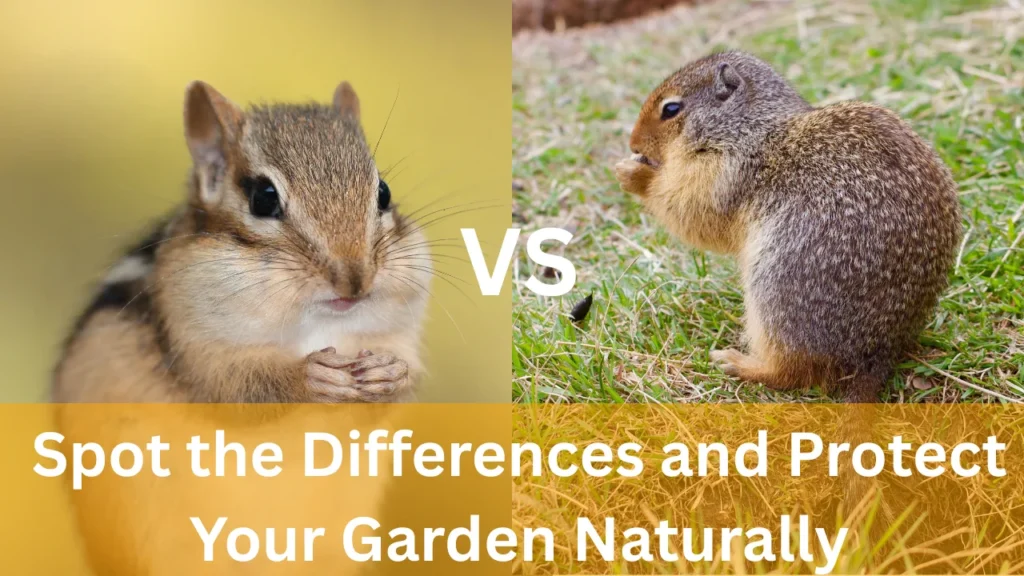Chipmunks and gophers both live in North America and often pop up in gardens, parks, and backyards. While they may look similar to the untrained eye, these two small animals are quite different. If you’re noticing holes in your yard, missing plants, or animal tracks, identifying whether it’s a chipmunk or a gopher can help you manage the problem better.
This guide will help you learn the main differences between chipmunks and gophers, including their looks, habits, and impact on your garden. Using this information, you can take better steps to protect your yard and understand the animals living in your space.
Chipmunk vs Gopher Quick Comparison
| Feature | Chipmunk | Gopher |
|---|---|---|
| Size | 5–6 inches long | 6–10 inches long |
| Body Shape | Slim with stripes | Chubby and round |
| Fur Color | Brown with black and white stripes | Solid brown or gray |
| Cheek Pouches | Large and visible | Less noticeable |
| Burrow Entrance | Small and clean | Large with soil mounds |
| Diet | Nuts, seeds, berries | Roots, plants, vegetables |
| Activity Time | Day (diurnal) | Day and night (mostly underground) |
| Tail Shape | Fluffy and upright | Short and hairless |

Appearance: Small Details Make a Big Difference
The first way to tell a chipmunk from a gopher is by looking at how they look. Chipmunks are small rodents with striped backs—usually five dark stripes and two white ones. Their tails are fluffy and stick straight up. They move quickly and often climb trees.
Gophers, on the other hand, are larger and rounder. Their fur is solid-colored, with no stripes at all. They have short legs, small eyes, and almost no visible neck. Their tails are short, nearly hairless, and usually hidden.
Upcoming Door County Events You Shouldn’t Miss
Behavior and Movement: Above vs Below Ground
Chipmunks are active during the day and are often seen gathering food like nuts and seeds. They store their food in cheek pouches and bring it to underground dens. Chipmunks are quick, alert, and can climb shrubs, fences, and even bird feeders.
Gophers prefer to stay underground. They dig long tunnels using strong front teeth and sharp claws. These tunnels often damage gardens because gophers feed on plant roots. You might not see a gopher, but the mounds of dirt they leave behind show where they’ve been.
Diet and Garden Damage: Who Eats What
Chipmunks mostly eat nuts, seeds, berries, insects, and bird eggs. While they may nibble on garden plants, they do not cause major damage. They like to explore and often steal bird food from feeders.
Gophers eat the roots of plants, flowers, vegetables, and shrubs. They pull whole plants underground. If your garden looks like it’s been uprooted from below, chances are a gopher is responsible. Their chewing can damage irrigation lines and plant roots quickly.
Burrows and Tunnels: Clues Under Your Feet
Both animals live underground, but their burrows look very different. A chipmunk hole is small, neat, and without much soil around it. Their tunnels are shallow and usually built under trees or bushes.
Gopher burrows are much messier. They leave large mounds of soil in a crescent or fan shape. These mounds are entry or exit points for deep underground tunnels. Unlike chipmunks, gophers create big tunnel systems that stretch far.
Cheek Pouches: More Than Just Cute
One standout feature of chipmunks is their big cheek pouches. They use them to carry food to their nests. You might see a chipmunk with its face puffed out—it’s probably storing nuts or seeds.
Gophers also have cheek pouches, but they are less visible and used mainly to transport food underground. They don’t stuff their cheeks as noticeably as chipmunks do.
Tail and Ears: Quick ID from a Distance
Chipmunks have long, bushy tails and large ears that stand upright. These features help them stay alert and keep balance while moving.
Gophers have small, round ears and short tails. Since they spend most of their time underground, their tails are used for feeling their way in tunnels rather than for balance or display.
Signs of Each Animal in the Garden
Signs of Chipmunks:
- Striped fur seen around trees and shrubs
- Bird food disappearing quickly
- Small, clean holes near foundations
- Chirping or clucking sounds
Signs of Gophers:
- Fan-shaped soil mounds in the yard
- Missing plants and vegetables
- Soft ground and tunnels under the lawn
- No animal spotted above ground
Why Knowing the Difference Matters
Understanding whether you’re dealing with a chipmunk or a gopher helps in choosing the right control methods. Chipmunks are mostly harmless and often left alone unless they get inside homes. Gophers cause heavy plant damage and often require removal or traps.
Many people want humane ways to deal with these animals. Using natural repellents or planting gopher-resistant plants are common solutions. Some use fencing or underground barriers to protect gardens.
FAQs
Chipmunks have stripes, long fluffy tails, and move above ground. Gophers have no stripes, short tails, and live underground.
Chipmunks cause minor damage by digging or eating seeds. Gophers can destroy plant roots and leave big soil mounds.
Gophers can be active both day and night, but mostly stay underground. They are less visible than chipmunks.
Try fencing underground, using gopher-repelling plants, or natural sprays. Avoid harmful poisons if possible.
Yes. Chipmunks sometimes nest in attics or crawl spaces if entry points are open. Sealing holes can help prevent this.
If your yard has visible tunnels, damaged plants, or dug-up soil, take time to observe the signs. Check for stripes, watch their behavior, and look at the burrow size. This information helps you figure out which animal lives nearby and how to handle it.
You don’t always need to remove them. Sometimes, making small changes like moving bird feeders or using motion sensors can keep chipmunks away. For gophers, consult local wildlife experts or try physical barriers to keep your garden safe.
